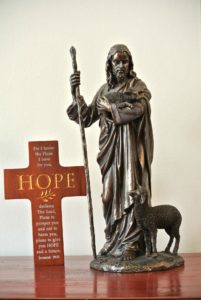The Flood of Noah is one of the centerpiece arguments for young-earth theology. Because of this, I have been asked what I believe the Flood of Noah was like.
To answer this question, let us first look at what the Flood is not…it is not the event that has been described by the young-earth theorists. There is no possible way the Flood could produce the rock record we see, nor could the flood produce all the coal layers, oil reserves, or chalk layers that we see in the rocks. If you want to explore these topics first, click on them to examine them in closer detail.
Was the Flood Global?
This is probably the biggest question I get asked. This will be a short answer to such a big question, but…no.
You may ask how I can believe in an inerrant Bible if I don’t believe the Flood was global. The Bible says the waters covered the entire face of the earth (Gen. 7:19). However, when considering any writing, one must take into account the author’s point of view.
What is the author of Genesis’s point of view? He is writing the story from the viewpoint of the witnesses, or, mankind. At the time of the Flood, mankind was still limited to the Middle East. Therefore, if you wipe out mankind, which all existed in one geographic area, you could easily say the Flood was global, since everywhere that man lived, it was flooded. Does that mean that North America was flooded? Think of it this way. You are in your house, and a flood comes and covers your entire house, leaving you sitting on your rooftop, with no land in sight. This flood event may not be global, or, over the entire surface of the earth, but to you, it is definitely ‘global’, for your entire world, all the land that you own, all the land that you can see, is flooded.
Or, think of it from Noah’s viewpoint. All the flood stories from around the globe originated from Noah, since all mankind is descended from him. If you are Noah, on the Ark, floating around with no land in sight for months on end, you too would certainly call the Flood global. Therefore from his viewpoint, global would be the correct word, even though there is no proof that the Flood actually covered the entire earth.
If the Flood was global, there is no proof that it covered the entire earth, either geologically or from writings, including the Bible. It was certainly ‘global’ from Noah’s viewpoint, but we can’t be certain that he completely circled the globe to prove that it was indeed global.
Food Supply
In Genesis 8:11, the dove that Noah sent out brought back an olive leaf as proof of dry land. Let’s look a little closer at this from a young-earth perspective.
In order to prove the Flood, and the necessary erosion that took place in order to deposit all the rock layers we see today, two young-earth theorists, Baumgardner and Barnette, worked out a simulation of the current patterns and speeds if the entire globe was covered in water.(Footnote 1) The important thing to note here is that the water currents were at least 131 feet per second, or more than 89 miles per hour! (Actual speeds varied between 89 MPH and 194 MPH). At that velocity, all previously existing trees would have been torn from their roots, and there would be no living trees or plants to survive the flood. So, where did the olive leaf come from? It would have to be a leaf from a seedling which the dove brought back, because none of the pre-existing trees would have survived.
Since none of these trees could have survived, there would have been no plant food for any of the animals (or Noah) to eat. How did the plant-eating animals survive after they were released from the Ark? The young-earth model cannot answer this.
How did the meat-eating animals survive? They would naturally have to immediately feed on the plant-eaters, which would have made them extinct within a matter of weeks. The young-earth global flood model again fails to answer this.
However, if the Flood were local, not global, then the animals would merely have to migrate a short distance to find food. Clearly, the local flood model is the only one which can logically explain survival of animal species after the Flood of Noah.
Wildlife Ranges
What about the other continents…where they flooded? Was Australia flooded? If so, how did the wildlife there, such as Koalas and Kangaroos, get to Australia from the Ark? Did they swim across the sea? Of course not. If they migrated from Noah’s Ark, you would expect Koala and Kangaroo populations to exist all along this migratory route…but they are only located in Australia. A young-earth flood model cannot explain the wildlife habitat ranges that we see today in Australia, nor the other continents.
Dinosaurs
Young earth theorists are quick to use dinosaur graveyards as evidence of Noah’s Flood. They claim the dinosaurs herded together, and then were quickly buried. However, this explanation is not feasible.
The dinosaur graveyards referred to are mostly in North America, in sediments in Utah, Wyoming, Colorado, Montana, and Canada. However, looking at the positioning of the rock layers, there are thousands of feet of sediment below these layers that the young-earth theorists claim were deposited by the Flood.
To make this more understandable, let’s look at the Grand Canyon. Steven Austin, in his book Grand Canyon: Monument to Catastrophe, claims the Canyon rocks represent those which were deposited during the rising waters phase of the Flood (Figure 4.1). The “Late Flood”, or receding water rock deposits, are the Mesozoic sediments.
It is interesting to note that all the dinosaur fossils, including the mass graves, are Mesozoic in age. This means that all the dinosaurs died in the receding water phase of the flood. However, it is clear from Genesis 7:21-23, that all life was killed during the first 40 days of the Flood. Some young-earth theorists will argue that the bodies floated around, and eventually sank, based on various factors as body size, density, and so forth. However, this cannot be true, because the dinosaur footprints all exist in the same Mesozoic rock layers, as do all the dinosaur coprolites (fossilized dinosaur poop), and fossilized dinosaur eggs. Clearly, the dinosaurs were alive and well, after the declaration in Genesis 7:21-23 that all living things were killed during the first forty days of the flood. Clearly, the young earth flood model cannot explain the dinosaur fossil distribution in the rock record. However, if one accepts a local flood event, with the dinosaurs having lived over 65 million years ago, there are no problems.
Conclusion
The young-earth flood model falls flat on its face when compared to the rock record. There is no global, geological evidence for a flood, nor can the young-earth model explain animal survival when there was no food supply, animal distribution ranges, nor dinosaurs which survived the first forty days of the flood.
The old-earth explanation can handle all these problems. You can believe in an old earth, and still believe in Noah’s Flood. It was not “global” over the entire earth, but it certainly was “global” if you were in Noah’s shoes.
FOOTNOTE:
1 Baumgardner and Barnette (icr.org/index.php?module=research&action=index&page=researchp_jb_patternsofcirculation)





